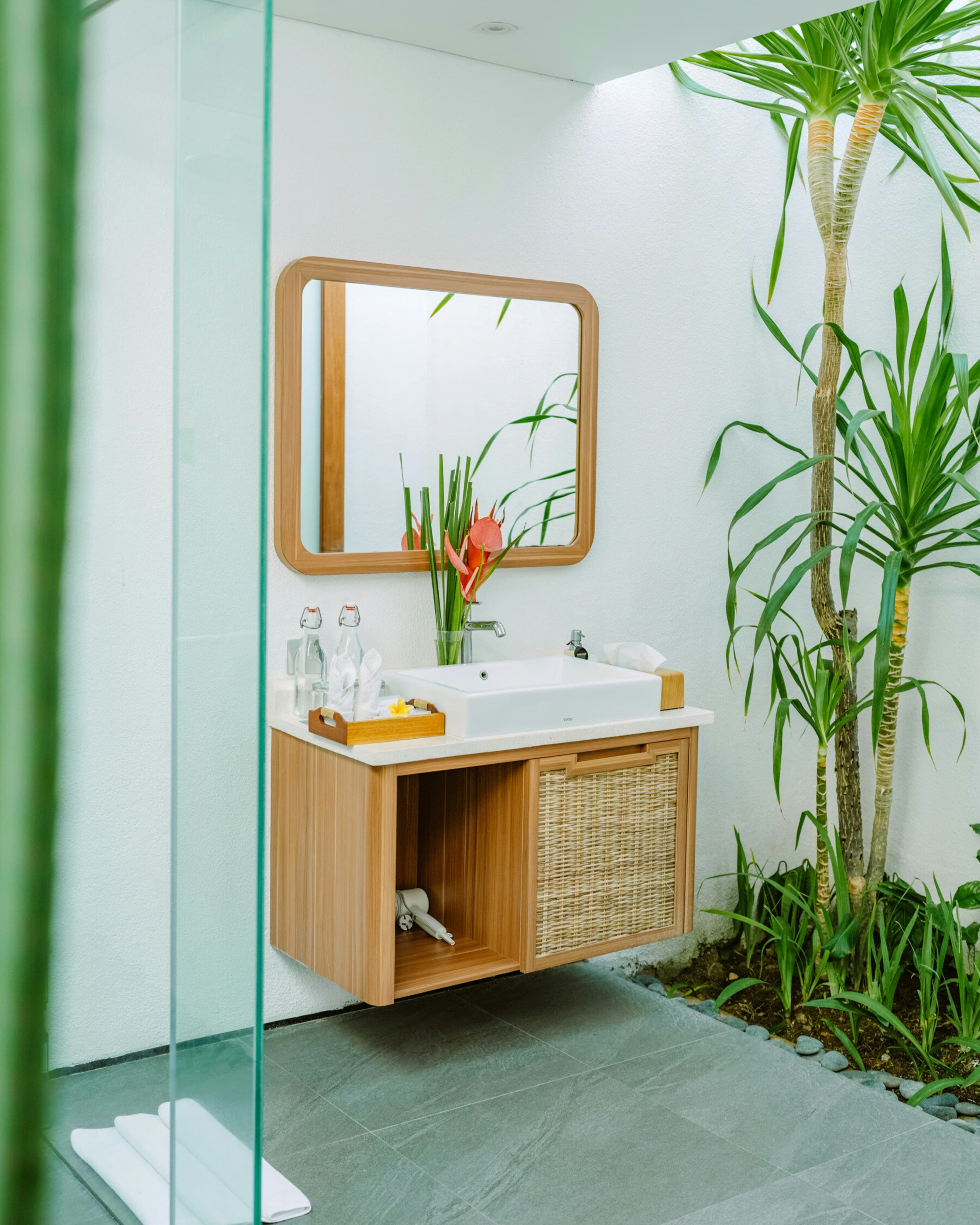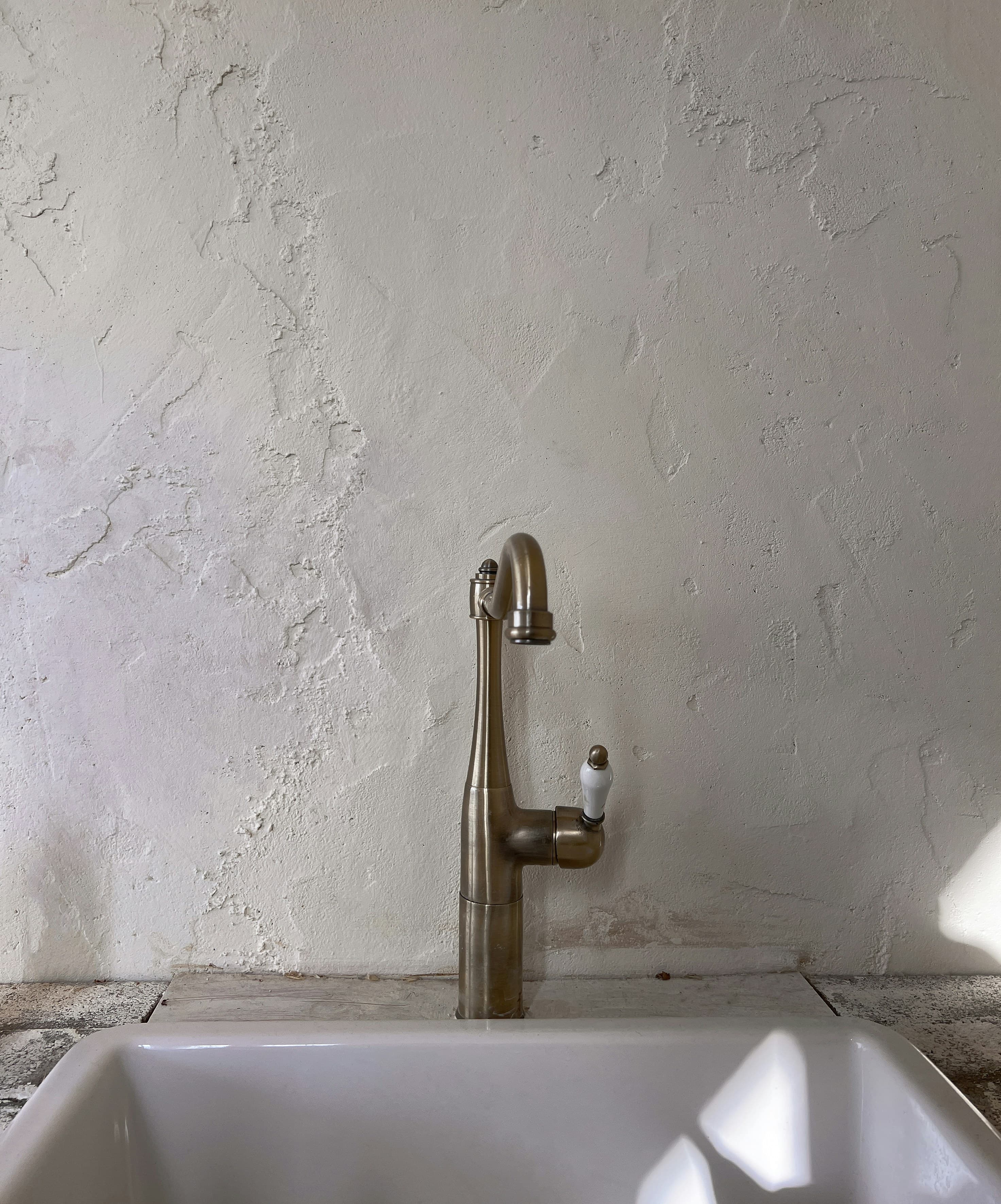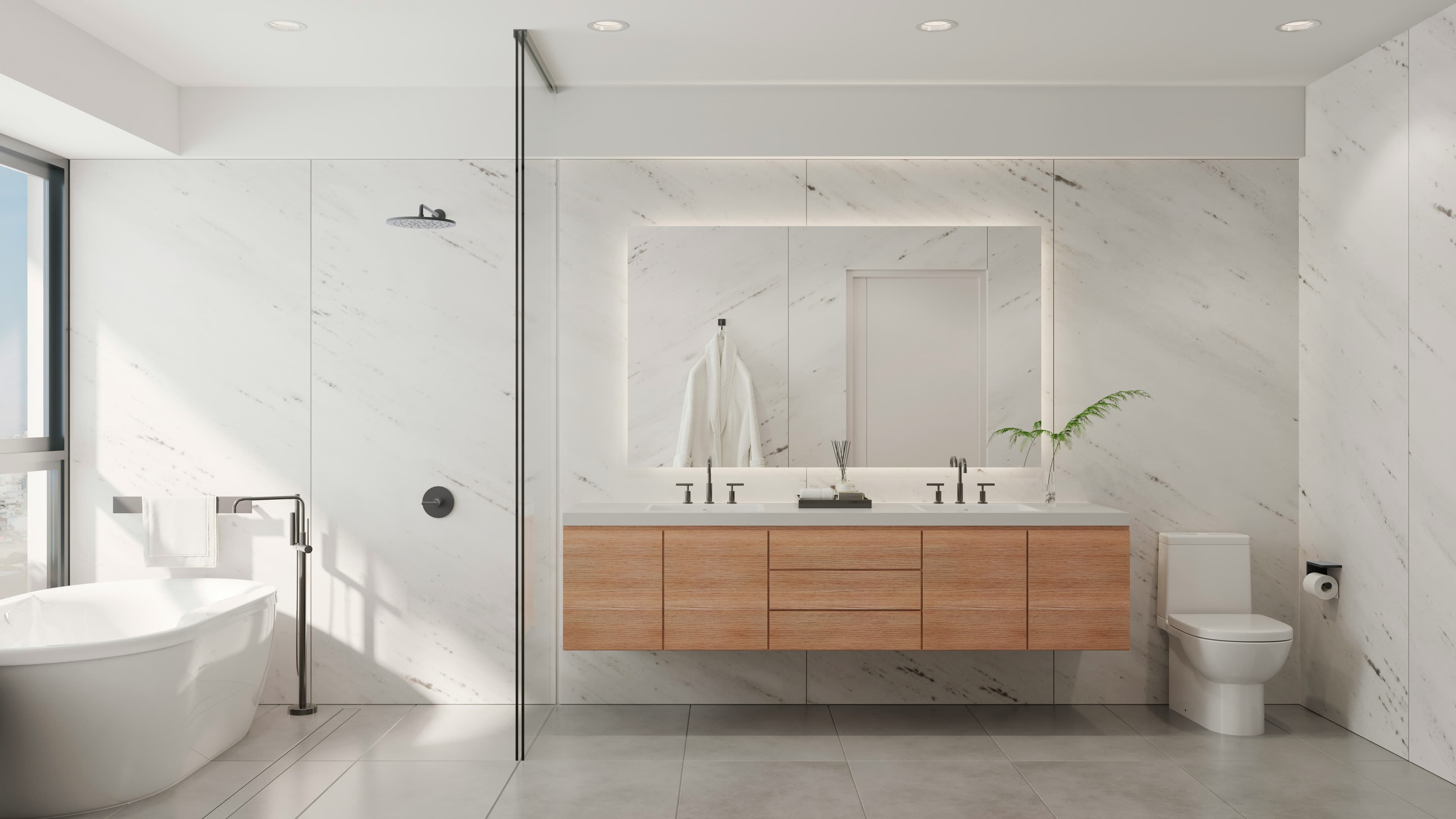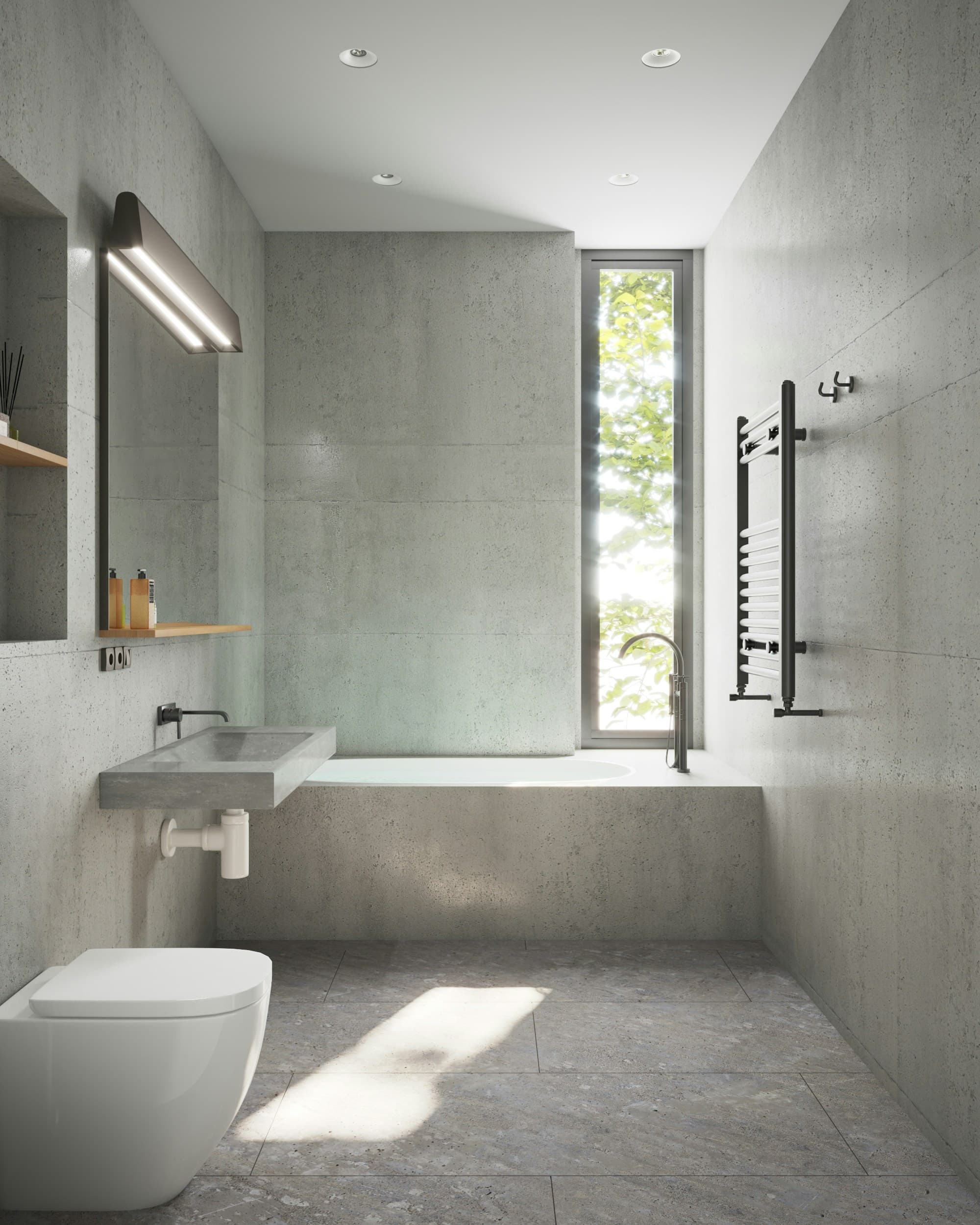
The Future of Sustainable Bathroom Design
As environmental consciousness grows, sustainable bathroom design has evolved from a niche trend to a fundamental approach to creating healthy, efficient, and beautiful spaces. This shift mirrors the sustainable design practices we see in kitchen design, where environmental responsibility drives innovation and user experience improvements.
The Principles of Sustainable Bathroom Design
Sustainable bathroom design is built on three core principles: environmental responsibility, resource efficiency, and human health. These principles align with the accessibility standards that ensure spaces work for all users while considering the broader impact on our environment.
Environmental Responsibility:
- Material selection: Choosing products with minimal environmental impact
- Water efficiency: Reducing water consumption through smart design
- Energy conservation: Minimizing power use through efficient systems
- Waste reduction: Designing for longevity and recyclability
Resource Efficiency:
- Space optimization: Making the most of available square footage
- Multi-functional design: Elements that serve multiple purposes
- Smart technology: Automated systems that optimize resource use
- Local sourcing: Reducing transportation impact through local materials
Human Health:
- Indoor air quality: Materials and systems that promote healthy air
- Natural light: Maximizing daylight for physical and mental well-being
- Ergonomic design: Spaces that support healthy movement and posture
- Biophilic elements: Connecting occupants with nature
Sustainable Material Selection
Choosing the right materials is crucial for creating truly sustainable bathrooms. This process requires the same careful consideration as design system development, where each component must work together to create a cohesive, functional whole. These material choices should be integrated into your overall bathroom layout optimization strategy, ensuring that sustainable materials are positioned for maximum efficiency and longevity.
Surface Materials:
- Recycled glass: Beautiful, durable tiles made from post-consumer waste
- Bamboo and cork: Renewable resources for flooring and accessories
- Recycled paper composite: Durable, water-resistant surfaces with unique aesthetics
- Natural stone: Locally sourced stone with minimal processing
- Concrete: Custom-cast surfaces using recycled aggregates
Fixture and Hardware Options:
- FSC-certified wood: Sustainably harvested timber for vanities and accessories
- Bamboo plywood: Strong, stable material with rapid renewability
- Reclaimed metal: Brass, copper, and steel with high recycled content
- Recycled plastic: High-quality fixtures made from post-consumer plastics
- Natural fiber: Organic cotton and hemp for textiles and accessories
Flooring and Wall Coverings:
- Cork: Renewable, comfortable, and naturally insulating
- Bamboo: Durable, renewable, and available in various styles
- Reclaimed tile: Glass and ceramic tiles with high recycled content
- Natural linoleum: Made from renewable materials like linseed oil and cork
- Recycled rubber: Durable, slip-resistant flooring options
Water-Efficient Systems and Fixtures
Water efficiency is a critical component of sustainable bathroom design, requiring thoughtful planning and innovative solutions. This systematic approach mirrors the UX research methods used to understand and optimize user behavior.
Water-Efficient Fixtures:
- Low-flow toilets: Reducing water use without sacrificing performance
- Water-saving faucets: Aerators and flow restrictors for efficient use
- Dual-flush systems: Different flush options for different waste types
- Touchless fixtures: Preventing water waste through automatic shutoff
- Greywater systems: Reusing water from sinks for toilet flushing
Water Management:
- Rainwater harvesting: Collecting and storing rainwater for non-potable uses
- Leak detection: Smart systems that alert to water waste
- Water filtration: On-site systems that reduce bottled water consumption
- Hot water recirculation: Instant hot water without running the tap
- Water monitoring: Real-time tracking of consumption patterns
Energy-Efficient Systems and Appliances
Modern sustainable bathrooms leverage technology to minimize energy consumption while maximizing functionality. This approach reflects the AI revolution in design, where smart technology enhances efficiency and user experience. These energy-efficient systems are central to modern bathroom design trends, where sustainability and technology work together to create bathrooms that are both environmentally responsible and highly functional.
Energy-Efficient Appliances:
- ENERGY STAR certified: Appliances that meet strict efficiency standards
- LED lighting: Long-lasting, energy-efficient illumination
- Smart thermostats: Optimizing heating and cooling for bathroom zones
- Motion sensors: Automatic lighting and ventilation for convenience
- Heat recovery systems: Capturing and reusing heat from hot water
Smart Energy Management:
- Automated lighting: Motion sensors and timers to reduce unnecessary use
- Energy monitoring: Real-time tracking of consumption patterns
- Renewable integration: Solar panels and other renewable energy sources
- Battery storage: Storing excess energy for use during peak times
- Smart controls: Programmable systems for optimal efficiency
Indoor Air Quality and Health
Creating healthy indoor environments is essential for sustainable bathroom design. This focus on human health aligns with the accessibility principles that ensure spaces work for all users, including those with sensitivities and health concerns. The principles of bathroom layout optimization are crucial here, as proper ventilation and air flow patterns must be carefully planned to ensure healthy indoor environments.
Air Quality Solutions:
- Ventilation systems: Proper air exchange to remove moisture and pollutants
- Air filtration: HEPA filters and activated carbon systems
- Low-VOC materials: Reducing harmful chemical emissions
- Natural ventilation: Windows and skylights for fresh air flow
- Indoor plants: Natural air purification and biophilic benefits
Health-Conscious Design:
- Ergonomic layouts: Reducing strain and promoting healthy movement
- Natural light: Maximizing daylight for vitamin D and circadian rhythms
- Acoustic design: Reducing noise pollution for better mental health
- Non-toxic finishes: Safe materials for wet environments
- Easy cleaning: Surfaces that resist mold and are easy to maintain
Waste Reduction and Recycling
Sustainable bathrooms are designed to minimize waste and maximize recycling opportunities. This systematic approach to resource management reflects the collaboration tools that help teams work together to achieve common goals.
Waste Management Systems:
- Composting: On-site systems for organic waste processing
- Recycling centers: Dedicated spaces for sorting and storing recyclables
- Reusable containers: Reducing single-use packaging waste
- Bulk storage: Minimizing packaging through bulk purchasing
- Waste prevention: Smart storage and planning systems
Circular Design Principles:
- Modular components: Easy repair and replacement of individual parts
- Upgradable systems: Technology that can be updated without replacement
- Local repair services: Supporting local economy and reducing waste
- Material recovery: Designing for easy disassembly and recycling
- Longevity planning: Durable materials and timeless design
Biophilic Design Integration
Connecting bathroom spaces with nature enhances both sustainability and human well-being. This approach to design reflects the mobile design trends that emphasize creating experiences that feel natural and intuitive.
Natural Elements:
- Indoor plants: Growing plants that thrive in bathroom environments
- Natural materials: Wood, stone, and other organic materials
- Water features: Small fountains or aquaponics systems
- Natural patterns: Design elements that mimic natural forms
- Seasonal connections: Design that responds to natural cycles
Biophilic Benefits:
- Stress reduction: Natural elements that promote relaxation
- Improved productivity: Better focus and creativity in natural settings
- Enhanced well-being: Connection to nature for mental health
- Educational opportunities: Learning about sustainability and nature
- Community building: Sharing sustainable practices and knowledge
Technology for Sustainability
Smart technology plays a crucial role in modern sustainable bathrooms, helping to optimize resource use and monitor environmental impact. This integration of technology and sustainability mirrors the AI revolution in design, where intelligent systems enhance human capabilities. The smart technology features discussed in modern bathroom design trends are particularly important for sustainability, as they enable precise monitoring and control of energy and water consumption.
Smart Sustainability Features:
- Water monitoring: Real-time tracking of consumption patterns
- Energy usage tracking: Identifying opportunities for conservation
- Waste analytics: Understanding and reducing waste generation
- Air quality monitoring: Ensuring healthy indoor environments
- Automated systems: Optimizing resource use through smart controls
Future-Forward Technology:
- IoT integration: Connected systems that work together seamlessly
- Predictive analytics: Anticipating needs and optimizing resource use
- Renewable energy integration: Smart systems that work with solar and wind
- Battery storage: Storing excess energy for optimal use
- Smart grid integration: Participating in energy demand response programs
Conclusion
Sustainable bathroom design represents the future of home design—spaces that are not only beautiful and functional but also environmentally responsible and healthy for occupants. The principles that guide sustainable bathroom design—environmental responsibility, resource efficiency, and human health—are the same principles that drive successful digital design.
By embracing sustainable design practices, homeowners can create bathrooms that serve as models of environmental stewardship while providing exceptional functionality and beauty. This approach ensures that bathroom designs remain relevant and valuable for years to come, just as well-designed digital products continue to serve users effectively over time.
The key to successful sustainable bathroom design is understanding that environmental responsibility and exceptional user experience are not mutually exclusive—they are complementary goals that, when pursued together, create spaces that are better for both people and the planet. This holistic approach to design ensures that our bathrooms contribute to a more sustainable future while serving as personal sanctuaries for health and wellness.


